|
|
Mayan Coronas
Jaguars & Serpents
|
13.0.7.6.4 | |
I have a vague recollection of the driver calling out "Bacalar, Bacalar" as we pulled up at the resort town a few miles North of the Mexican border with Belize. We were originally due to be here on Friday if the tour hadn't been rudely interupted. It was still dark outside, so we hardly bothered opening our eyes. We still had a few more hours to go.
The sun began to rise an hour before we got to Tulum, gradually waking us up for our disturbed slumber. At 7:25am precisely we pulled into the ADO bus terminal, a far more modest station than the one we left in Villahermosa.
Our hotel, Casa Agape Boutique, was little over half a mile away but we weren't going to waste time walking there. Taxis patiently waited outside the bus station to catch tired passengers like us who just wanted to go straight to their hotels. At only 50 pesos and a four minute journey we didn't feel ripped off. It was so worth it!
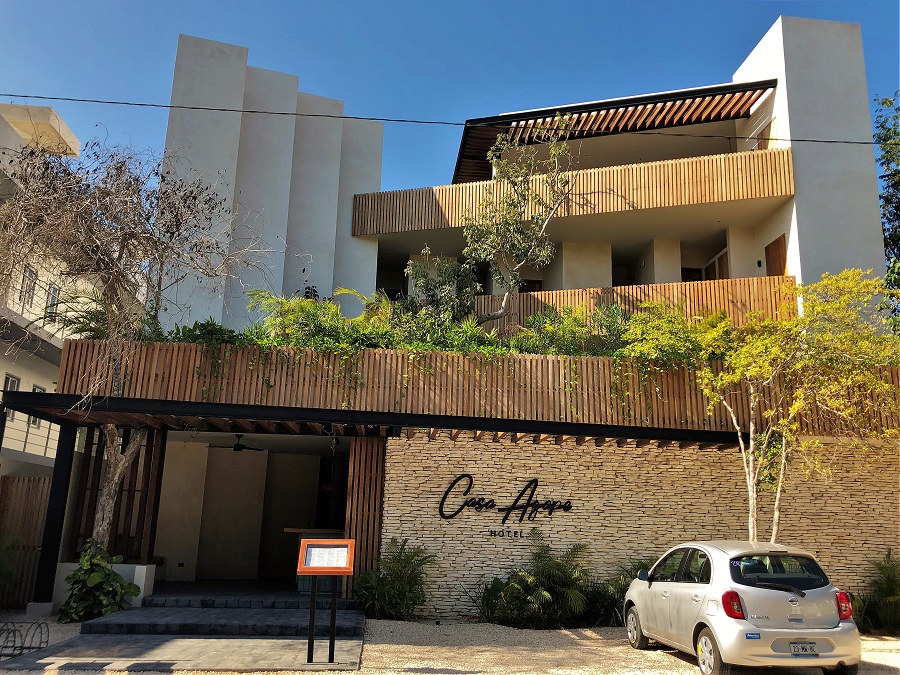
We couldn't remember what exactly we had booked. The photos, from what we coud remember, looked nice on booking.com but the main factor was the cost. It was reduced by a decent margin. When we saw it for the first time we were more that happy. It was a fab looking modern hotel, set at odd angles with wood and brickwork disguising the ugly concrete frame.
They were expecting us. We had a room booked for last night but as the hotel reception didn't open until 7am the night's watchman had our keys if we arrived in the middle of the night. But as we missed our first bus we were over an hour later than planned.
Anuwau, we checked-in and were given the keys to room number 1.
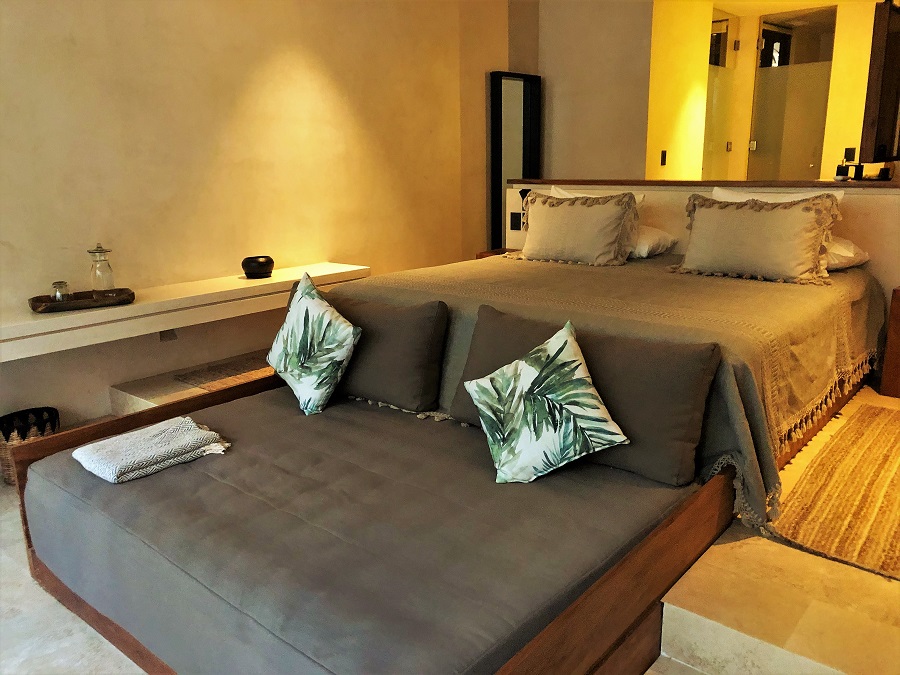
It was a beautiful sight, a split level room, with a king size bed, and then a day bed at the end of it. The enitre wall facing was glass looking out into a small gravel "garden" with a hammock hanging there, just waiting for me. The fact that all of this was for the price of a travelodge back home made us smile even more.
The temptation to crash out and grab a few hours sleep was strong but stronger still was our need for breakfast. The 2200 pesos per night was a relative bargain but the room rate didn't include beakfast.
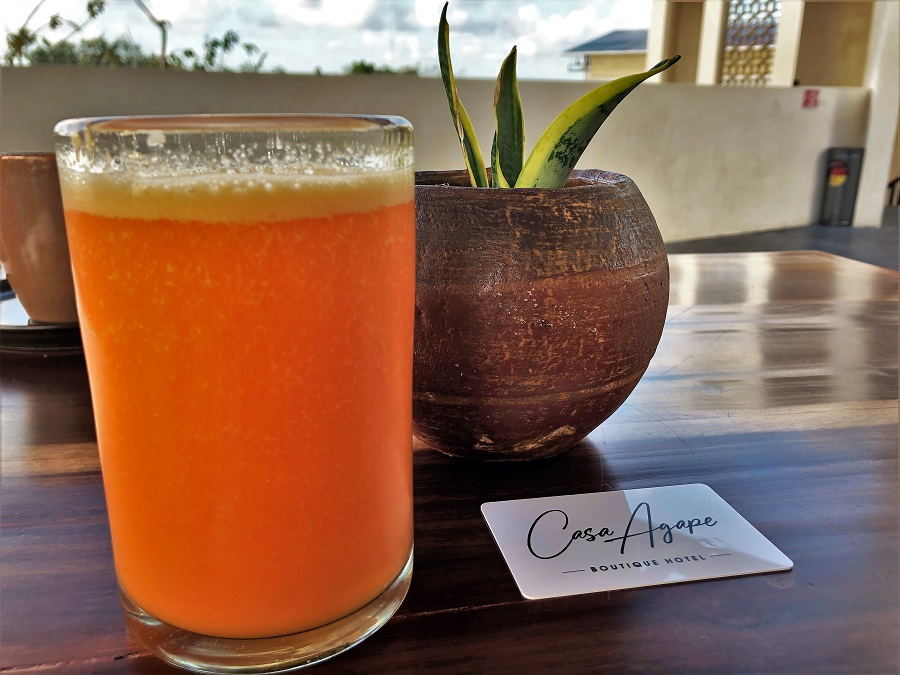
It was served in their rooftop bar which also had a small pool.
We browsed their desayanos menu and saw this drink they called the anti-flu smoothie. The drink of the moment during a global pandemic! But actually, after two days of travelling we both had sore dry throats and weren't feeling a 100% so we felt we needed it. We shared a glass of this delicious blend of carrot, orange and ginger. "Prevention is better than a cure" we both agreed.
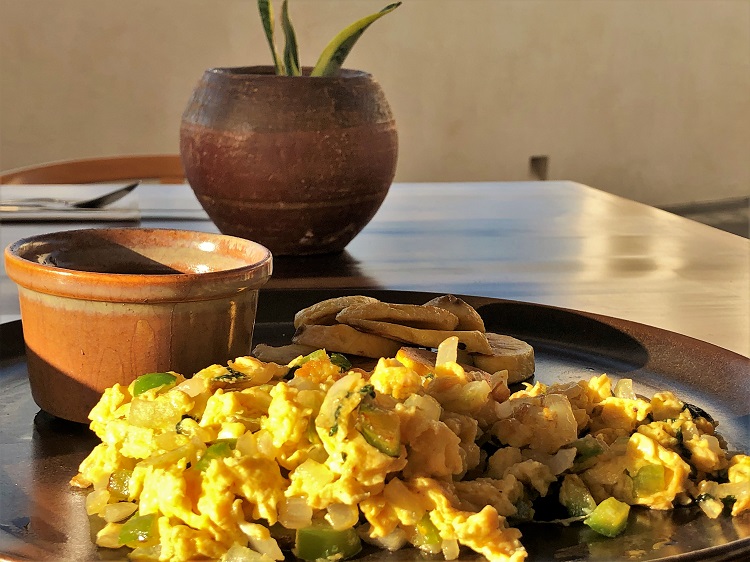
For breakfast I went for the huevos a la mexicana, the scrambled egg with jalapeno peppers and onion and usually tomato, but not today. (Listen to me, sounding like an expert after only two breakfast in Mexico!) I only know I'm right because it's the green, white and red of the jalapeno chilli, onion and tomato also represents the colours of the Mexican flag. Regardless; it was fresh and tasty.
Julie didn't go local today. I mean, two days in a row would have been most peculiar. Instead she opted for the delicious and comforting familiar French toast. The portion size was so large she only managed three out of the four pieces. (I had the last piece!)
Whilst eating we overheard another guest talking about Chichén Itzá, the most famous of all Mayan ruins, and how they had heard it was about to close to the public as a precaution over the pandemic. We desperately wanted to tick one thing off the bucket list whilst on this trip so after breakfast we went to the hotel reception where we asked Octavio if he knew anymore about it.
He didn't but he searched the internet for information. "It's open today for sure" he said, "It's definitely closed from Friday, I think. I don't know about tomorrow." His vagueness was confusing us. The only definite answer was it was open today.
"Can we book a trip to go there today?" asked Julie. "Yes" he replied and made the call. "You will leave in 15 minutes".
"OK" we said whilst thinking "shit, we need a wash" We ran back to our room for some speed showering and got changed in a flash.
I needed more cash, the trip cost 4000 pesos and I had to pay the driver. So I had to jog over to the Pemax garage on the corner of the main road, where inside the GoMart store they had an ATM. By the time I got back to the hotel I needed another shower!
There was no time as Diego, our taxi driver for the day had arrived. For the £80 each we had his service for the day, which included taking us to Chichén Itzá, a cenote (or sink hole) called Ik Kil and visit the city of Valladolid.
At 8:45am we were back on the road for a two hour drive. It really felt like we were in a race! (As it happens we weren't the first of our group to reach Chichén Itzá. Christian sent a photo to the What's App group yesterday!)
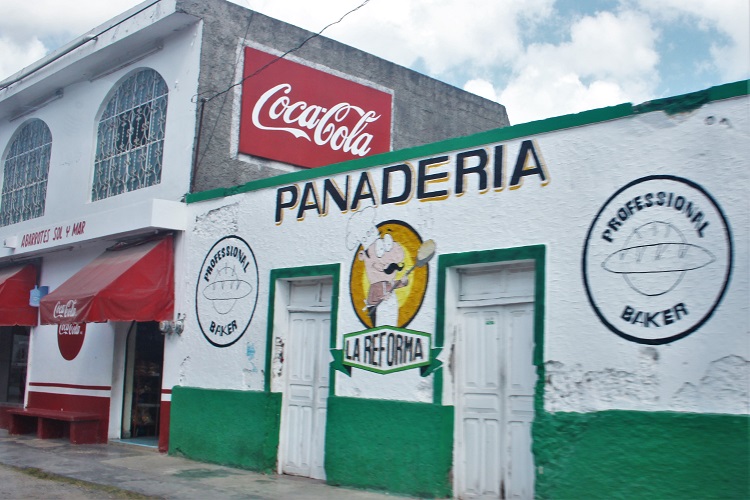
We didn't pay much attention to the world outside our window as we tried to catch some sleep as best we could. The road took us North through the towns of Coba, Chemax, skirting around Valladolid.
It took us two hours to reach Chichén Itzá. We pulled into the car park of the UNESCO World heritage site. It appeared busy. I guess everyone wanted to get here before it closed. We parked up and we arranged with Diego to have two hours here. There wasn't a queue at the ticket booth despite how busy the car park seemed .
We paid around 460 pesos for the two of us (£19), which wasn't too extortionate considering it is one of the "New Seven Wonders of the World". It's certainly Mexico's most iconic site and the most visited with 2.6 million tourists flooding here every year.
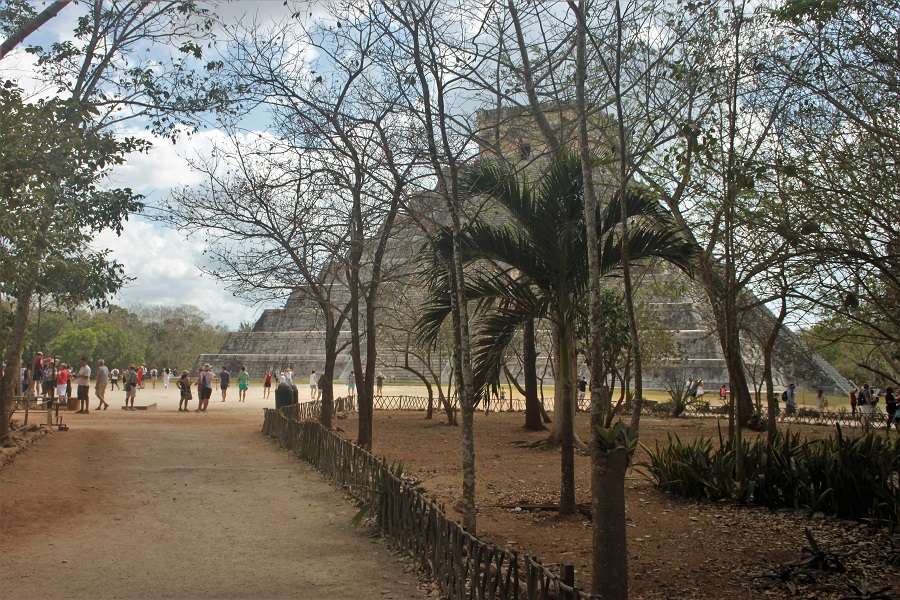
We followed the path through the trees ignoring the tour guides hopeful for some business . We could see the outline of the great pyramid in the distance. At last we made it to see a real Mayan temple, a bonafide wonder of the world. I must admit I got quite emotional.
Today was K'an, day of fire and symbolises the possibilty to distangle yourself, a good day to get rid of anger. How true it was that the release of all the frustration built up over the last couple of days was a beautiful feeling.
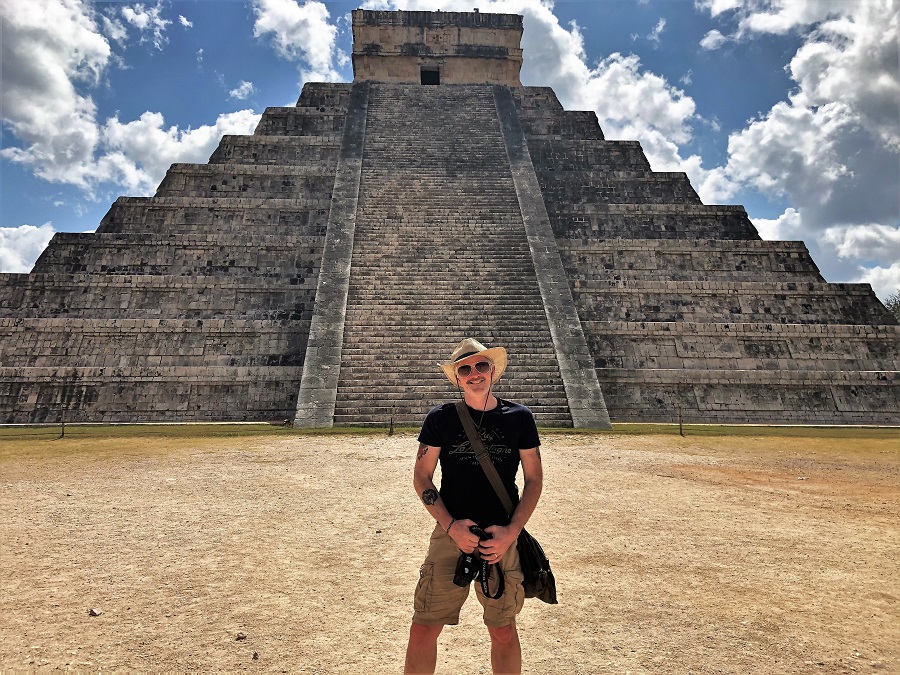
We walked across the wide open space of the grand plaza in front of El Castillo, the immense pyramid at the heart of this ancient Mayan city. We stood in front of it with an uninterupted view for such a long time. It briefly felt like we were on our own.
However, disturbing the peace were these piercing shrieks from the countless souvenir stalls trying to sell jaguar whistles, annoying instruments that made an awful cat call noise when blown through.
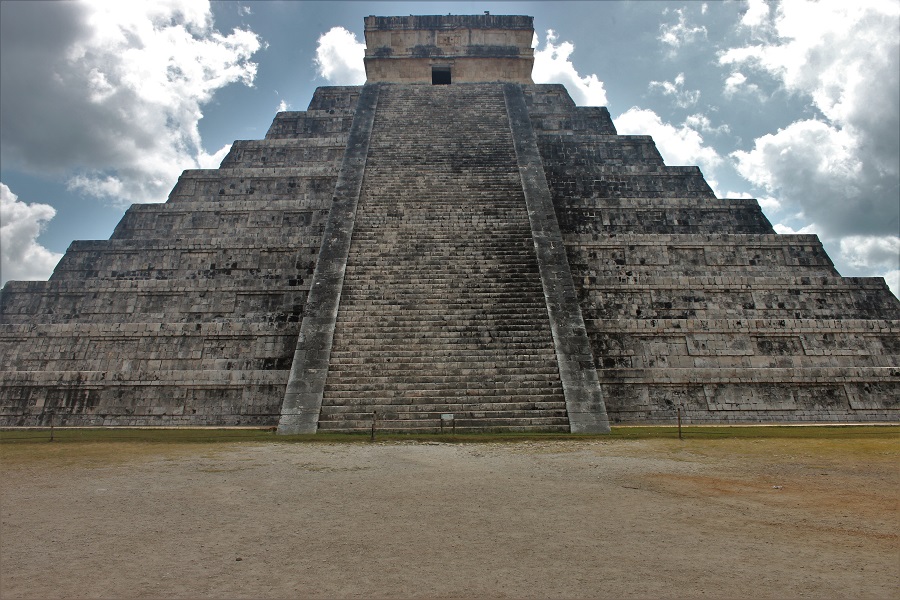
El Castillo, also known as the Tempe of Kukulcan was certainly an impressive structure. Although at only 30m it didn't compare to the colossal pyramids of Giza, Egypt which are almost 5 times the height.
The area was first settled in the 5th century but it's believed that this temple was built sometime between the 9th and 11th centuries, over the top of a previous smaller pyramid temple. It's odd to think that it was during this period the Mayan civilisation went into a rapid decline. The major cities to the South were abandoned and left deserted, the end of the Classic period as it's known.
Inside El Castillo are many chambers, some contained human bones, thought to have been victims of sacrifice, another was called the throne room because it had a red jaguar shaped seat.
At one time you could enter the pyramid, also climb the 91 steps up to the temple that sits at the top but all that stopped in 2006 when a tourist fell to her death.
We walked around the temple, admiring its beauty. The West and North sides had been restored to a near perfect finish. I couldn't imagine it looking any better the day it was built!
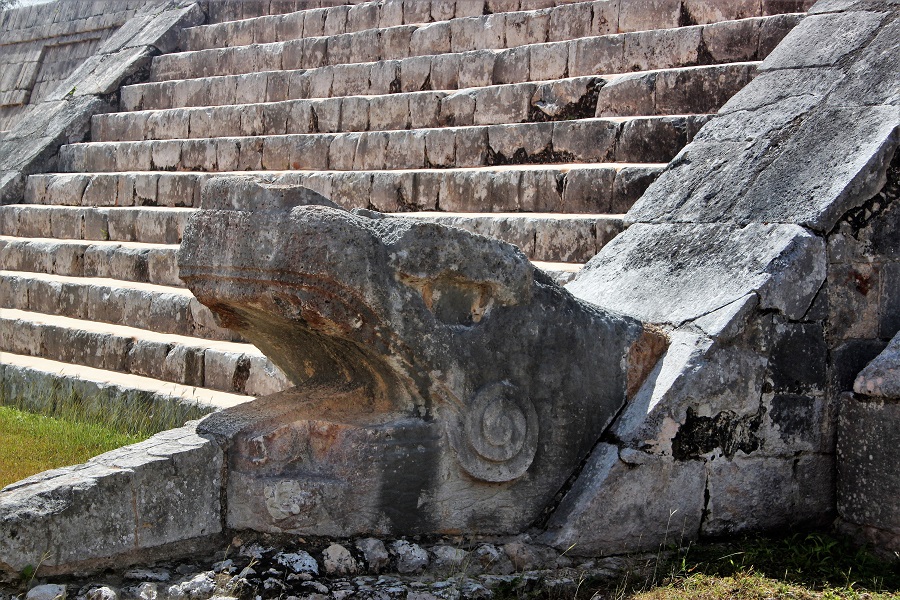
At the base of the steps of the North side were the heads of the feathered serpent Kukulcan. Apparently at sunset during the spring equinox thousands of people flock here to witness a trick of the light, an event known as the Descent of Kukulcan. That'll probably be why the authorities are closing the site on Friday. The equinox falls on the 20th March this year. They were expecting in the region of 20,000 people.
It certainly wasn't overrun with people today, and keeping our two metre "social distance" was straightforward. Still there were plenty of people here.
Every now and then a group, instructed by their guide, would stand at the base of the steps and clap, then marvel at the echo, as it travelled up the pyramid, resembling the chirp of the quetzal, the Mayan sacred bird.
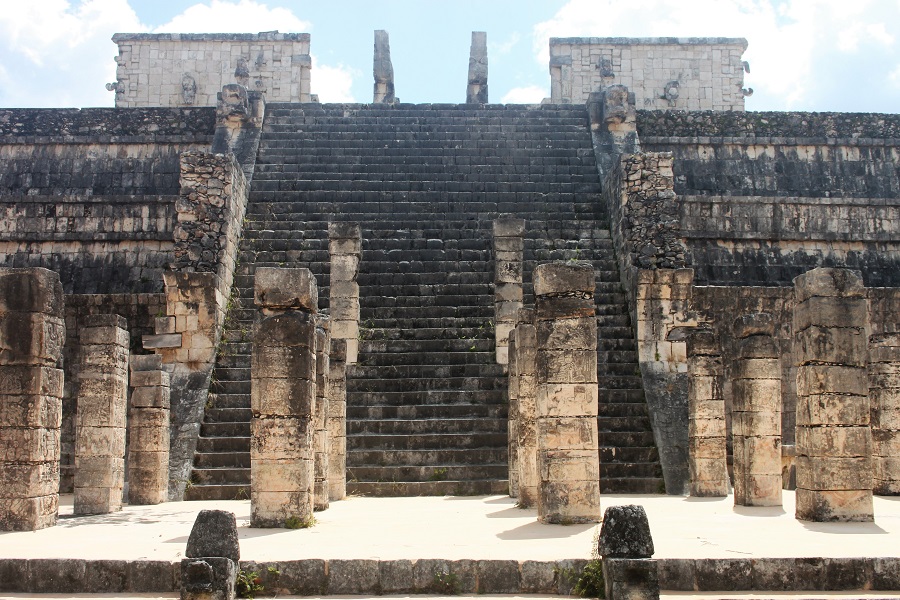
We left Kukulcan and walked across the plaza East to the Temple of the Warriors. It was built like the start of another stepped pyramid but stopped after the third tier.
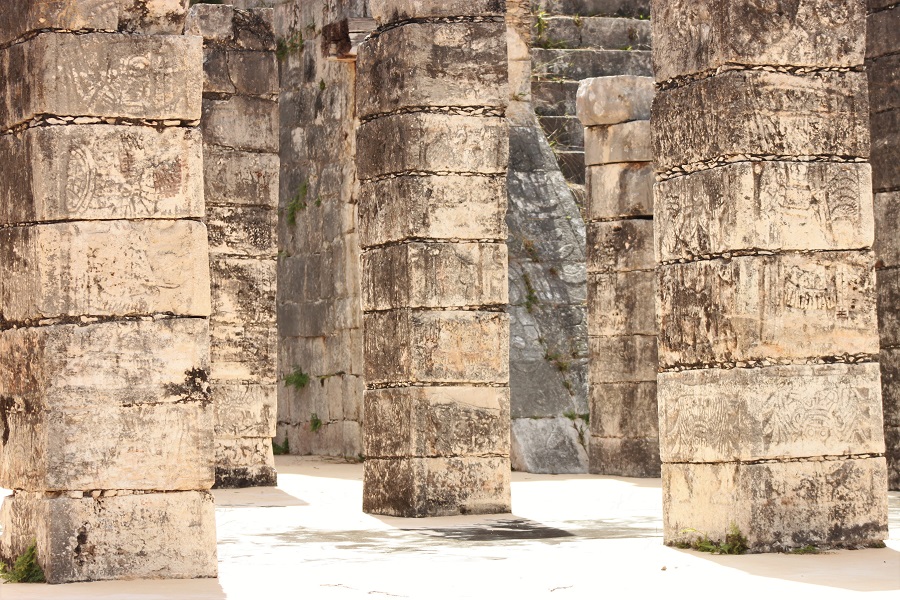
In front of it were many pillars, large blocks of stone stacked on top of each other. They were said to have carved bas reliefs of Toltec warriors and scenes of war but we couldn't get close enough to see any of the detail. Although we noticed the faintest colour of paint that would have covered them. They would have originally looked quite different brightly painted and supporting a thatched roof, In fact, most of the bare stone would have been decorated, even the great pyamid.
Next to the Temple of the Warriors was the less dramatically name the Temple of the Large Tables. A smaller temple tucked away, hardly noticable because of it's domineering neighbour.
In front of each structure there was a tri-lingual sign, with a short description in Spanish, English and Yucatec Mayan. Being Welsh it was great to see the minority language having such prominence.
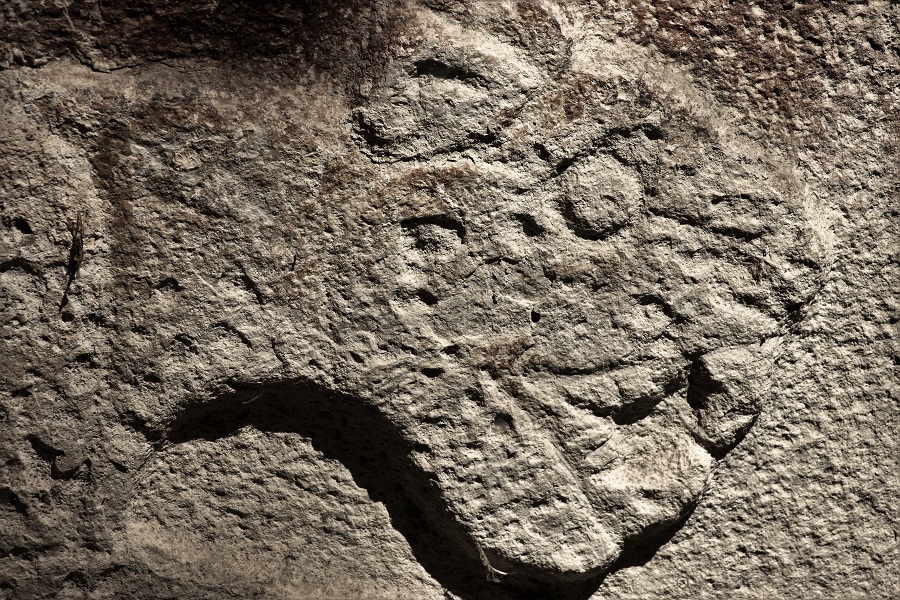
We then followed the perimiter, admiring a low-level gallery, a collection of bas-reliefs. This wasn't their original location, they were bits and pieces curated from all over the site. I'm not too sure why they were gathered here to form a wall or whether in fact if they were relpicas.
Many of them were simply patterns of plummage or similar but every now and then you could make out a dramatic snake's head or a jaguar.
We continued along the Northern edge of the grand plaza, in the shade of the trees, avoiding eye contact with the many traders who sought our attention with a sharp growl down their jaguar flutes, oblivious to the fact I would have been far more inclined to browse their souvenirs if it wasn't for that annoying noise.
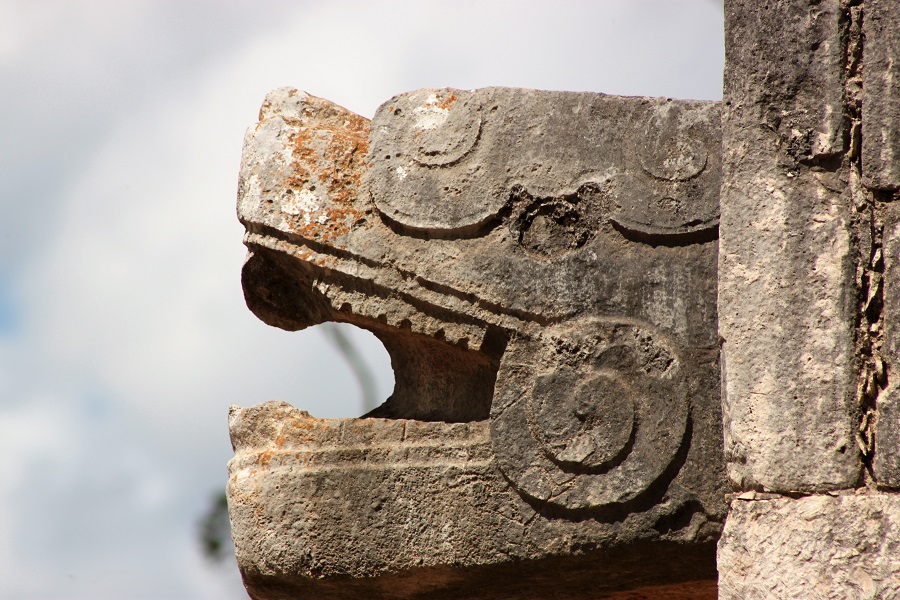
Next we came to the Platform of Venus, one of the public stages. It was decorated with many bas-reliefs of mythical creatures, half-eagle half-jaguar, half-serpent, half-man. It's believed that ritual offerings to the gods would have been performed on these platforms. Precious items like jade, gold, shells would be given to the priest.
The most common form of offering would have been a self-sacrifice in the form of bloodletting. No death involved. The offerer, quite often the king, would pierce themselves, spilling blood onto paper, which was then burnt to honour the gods. The most painful form of bloodletting was the piercing of the penis. My toes are curling just thinking about that one!
Of course the sacrifice most commonly associated with the Maya is human sacrifice. Usually prisoners from rival city states would be killed to apease the gods and ensure glorious victory over their rivals. The method of their killing became increasingly brutal, from decapidation to ripping out the still-beating heart of the victim to present it to the gods.
Apparently human sacrifice rituals were still being carried out as late as the 17th century when Spanish conquistadors recorded witnessing such events, although the power of the Mayan city states had long gone by then.
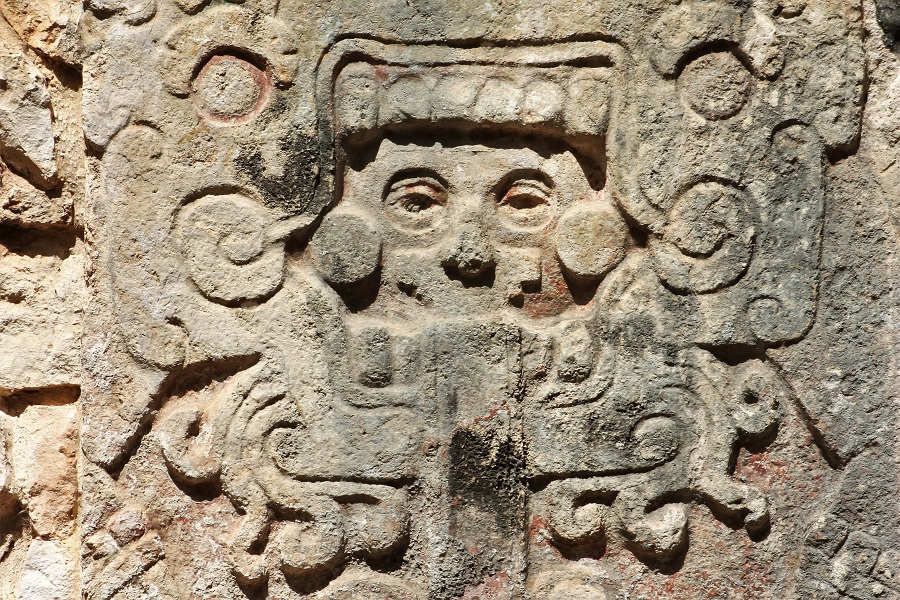
There was a face in the stone of the Platform of Venus, a haunting face with heavy eyelids looking at me from the 11th century. From his neck came what looked like snakes but others believe the serpentine lines represent pouring blood and this is in fact a depiction of decapitation.
People do seem to be quite fixated abouth all the sacrfice as if it's the only thing the Mayans were known for.
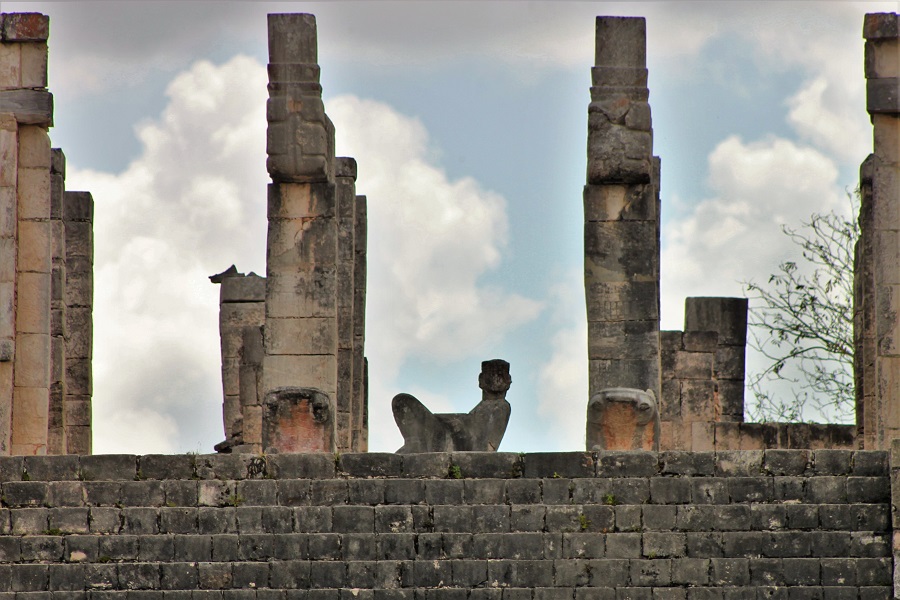
Our route was taking us towards the entrance, which was also the exit, so we turned around.
Walking back towards the Temple of the Warriors we noticed a reclining figure known as a Chacmool. Sat on the floor, resting on his elbows,with his face turned to face those gathered below. It would have a bowl carved on his stomach into which offerings to the gods were placed.
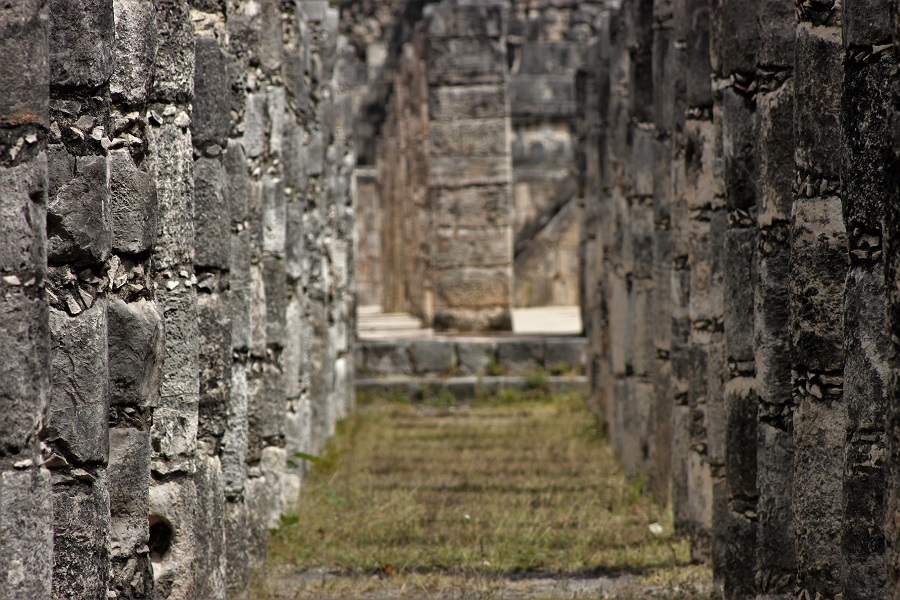
Leading South from here were hundreds of columns, laid out in four rows. In a slight exaggeration, they were called the Group of a Thousand Columns. We followed a path cutting across the plaza of pillars, to where a colonade of columns continued East from the temple, towards another structure known as the Marketplace. These were plain structures not decorated as the more ceremonial temples.
In its heyday Chichen Itza would have had a population of around 50,000. The markets would have been buzzing with activity.
From el mercado we double-backed on ourselves, walking through the woods. In the shade of the trees there were plenty of souvenir stalls, the modern day marketpace. "One dollar, almost free" they called out. "Blow in here" said another trying to pass me his saliva soaked jaguar whistle.
We began to feel sorry for them. This global pandemic will be decimate the tourist industry.
We stopped at one stall, mostly because he had several little figurines that interested me. Also, he wasn't blowing one of those irritating cat wailing flutes. In fact he wasn't at all pushy.
I picked up a small carved figure not sure if it was Mayan or Aztec but it didn't matter. "20 pesos" was his price. I gave him a 50 pesos note but he had no change. (Ah, that old chestnut!) So I picked up another small statue and told him to keep the change. I'm useless at this bartering malarky. I'm pretty sure you're not supposed to pay more than the asking price!
A wall hanging/bed spread of Frida Khalo also caught our attention enough for us to stop and ask how much. It was too expensive, even at the half price starting point for any good barter. By the time we had worked out the conversion rate we had talked ourselves out of wanting it, even if it was "almost free" as they claimed.
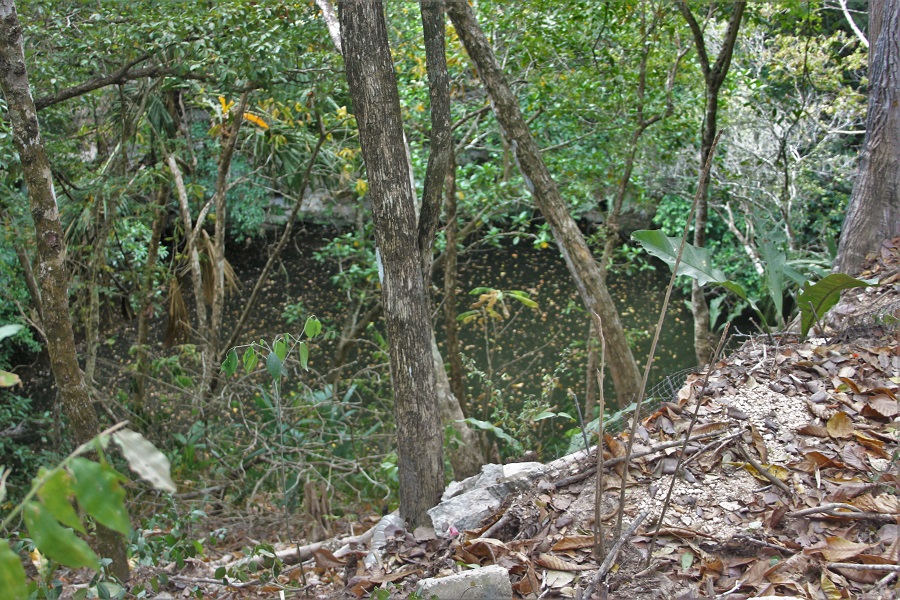
The path continued through the woods until we came to the Xtoloc cenote, A deep hole where the murky waters below was only just visible. Xtoloc was the Mayan word for iguana which had no connection with this being used as a resevoir. The name Chichen Itza however is derived from the word for "the mouth of the well" (chichen) and the Itza refers to the Itza people.
The entire Yucatan peninsula is littered with these cenotes, a geological phenomenom of porous limestoned ground creating a vast network of underground rivers. It's believed that the meteor strike that ended the dinosaurs occured here and is a major factor.
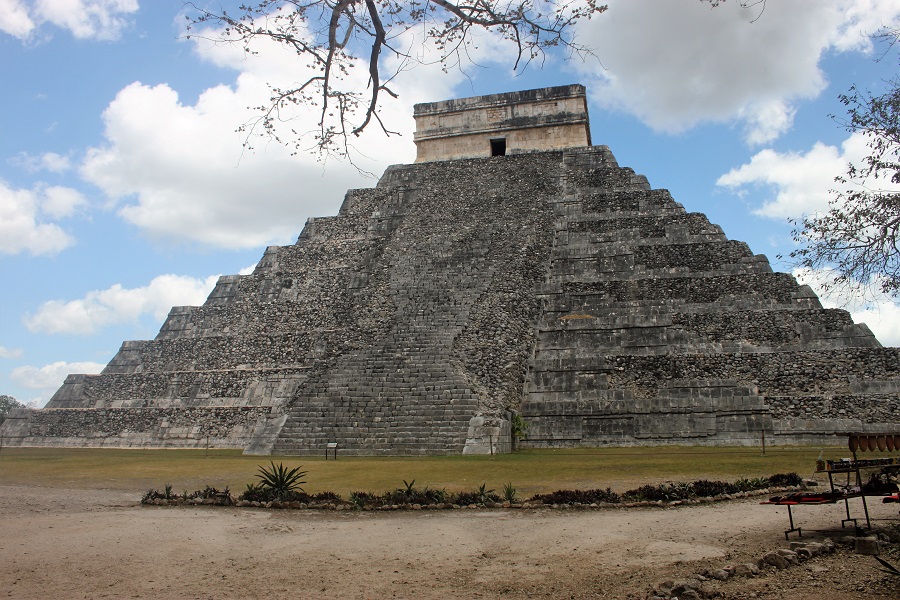
We returned towards the Temple of Kukulcan where we noticed that the South side of the temple had not been restored. Without the cladding panels you could see the bare stone used in its construction. Thousands upon thousands of rocks piled on top of each other, like a dry stone wall back home.
We crossed the grand plaza returning to the Platfrom of Venus, and then continued along the path towards another cluster of buildings such as the Temple of the Eagles and Jaguars and the Tzompantli.
A tzompantli was a wooden rack where the decapidated heads were put on display.
The stone platorm on which the skull dispay cabinet would have stood was decorated with the bas-relief of the tzompantli. Unfortunately we couldn't find it. We also missed the path to the Sacred Cenote, the sink hole into which apparently human sacrifices were thrown into. That's when having a guide would have been really useful!
I also realised (much later) we had also completely missed an enitre section, the older Southern district of Chichen Itza. Nevermind.
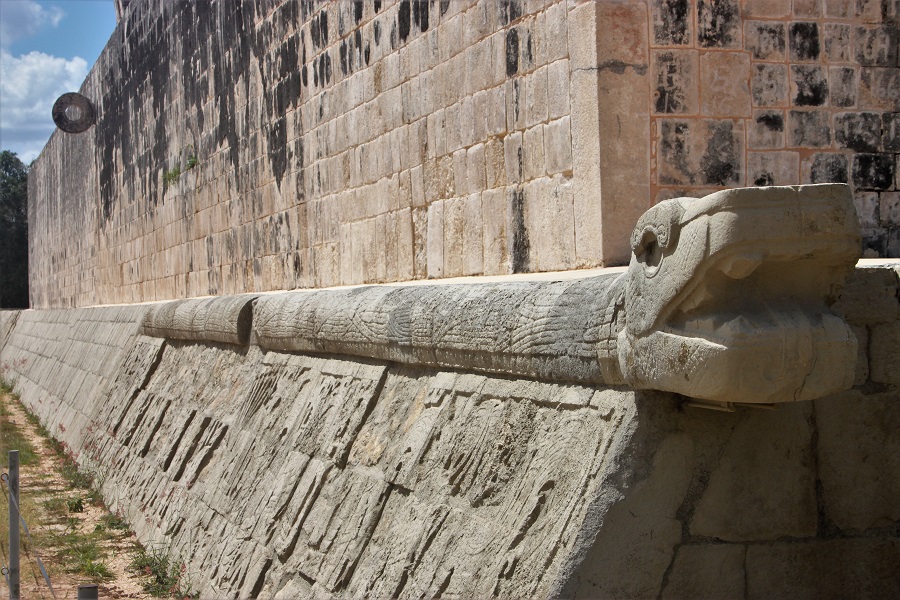
We walked behind the Temple of Eagles and Jaguars and came across a long open courtyard, with tall stone walls down the sides. Running along the base of the walls was a carved snake, its head sticking out on opposite ends.
This was a playing field, a ball court where a game called pok-ta-pok was played. It was a very popular sport across the whole mesoamerican region and this court was the largest of them all.
The game involved throwing a heavy rubber ball through a stone hoop high up on the wall. There was a "goal" on both walls, with the opposing teams battling it out in the middle, scrapping for the ball. I imagine it was like a brutal hybrid game of basketball and rugby.
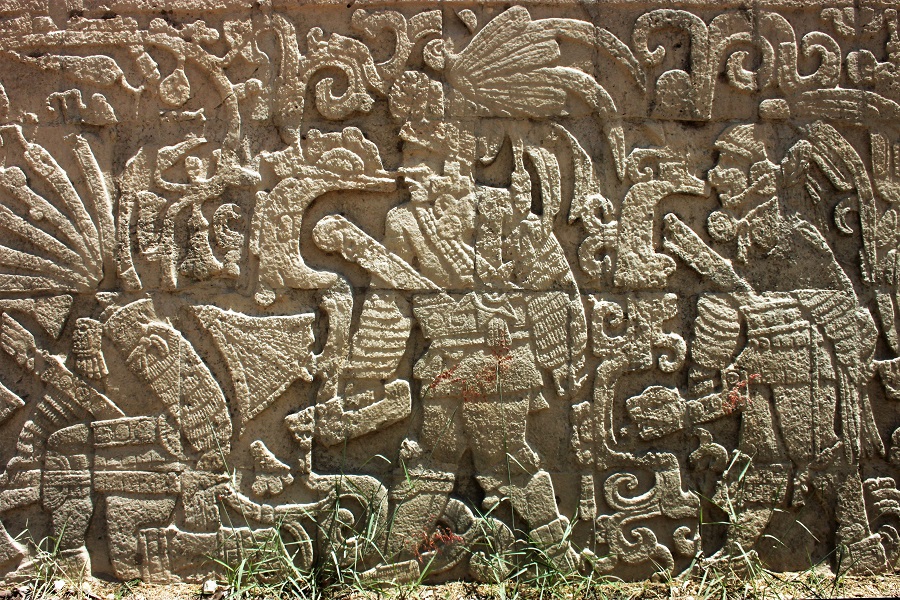
At the bottom of the wall, where it sloped sligtly, there we a few panels of very decorative bas reliefs. Images of warriors in full battle costume perhaps to inspire the ball players into a heroic performance.
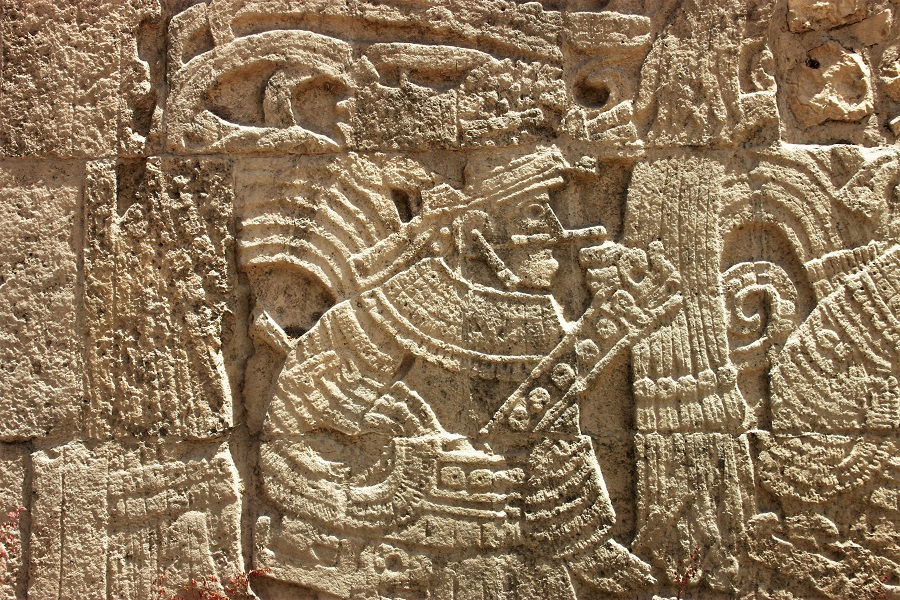
They all appeared to have a bar through the nose. I couldn't imagine gaining any advantage from wearing one, in fact quite the opposite. Surely it would make the warrior vulnerable to submission, like a ring through a bulls nose.
The carvings were absolutely fascinating. You could see the full plumage of their headgear, the detail of their protective collar, shoulder pads and wristbands and this peculiar phalic club protruding from their midrift.
Also, dotted about the scattered scene, were images of severed heads, skulls with feathered strands below the neck. These have lead some people to suggest that perhaps sometimes instead of a rubber ball an actual decapitated head may sometimes have been used in the game.
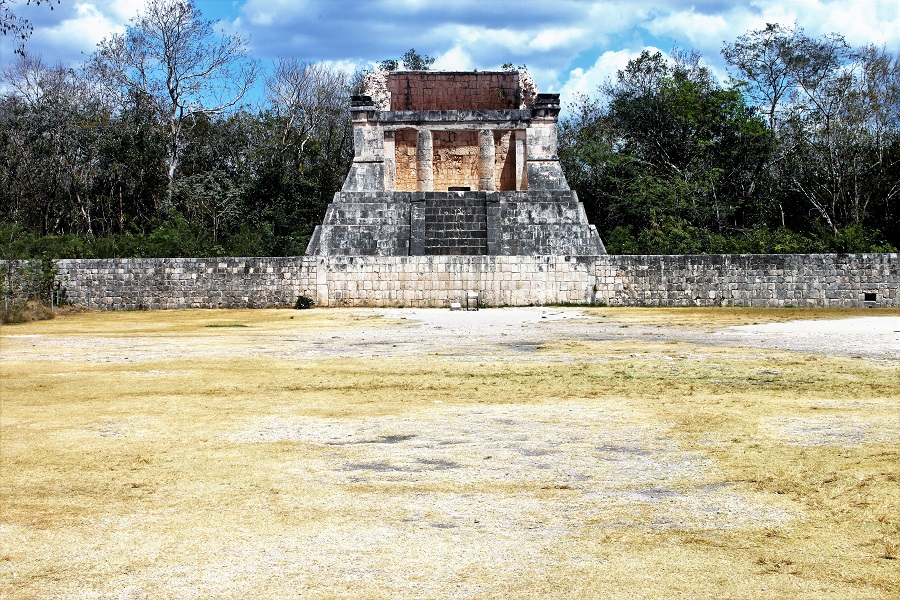
We walked all the way down the ball court, where at the very far end was a small structure called the Temple of the Bearded Man. All the images we've seen of Mayan life never showed men with beards. So why is there a bas-relief image of an Abyssinian on the back wall of this temple?
Some people believe that the whole mesoamerican culture is derived from some Egyptians who managed to sail across the Atlantic and bring with them the concept of a pyramid and hieroglyphs.
I find that hard to beieve.
After the ball court we decided it was time to leave. Obviously we didn't know at the time there was still a third of the Chichen Itza site yet to be discovered but no matter, we had seen what we had come here to see.
Diego was waiting for us by his car, ready to take us to the next stop on our day trip, Cenote Ik Kil. It was only a short drive away.
We paid our entrance fee and walked towards the centre of the attraction, passing a few restaurant and even an on-site hotel with a swimming pool. There was no sign of a sinkhole anywhere. "It's around here somewhere" I said, getting a little frustrated.
Eventually we stumbled across some steps that lead down into the darkness. Neither of us had any swimming costumes so we weren't going for a dip but we could see a balcony and we went down for a closer look.
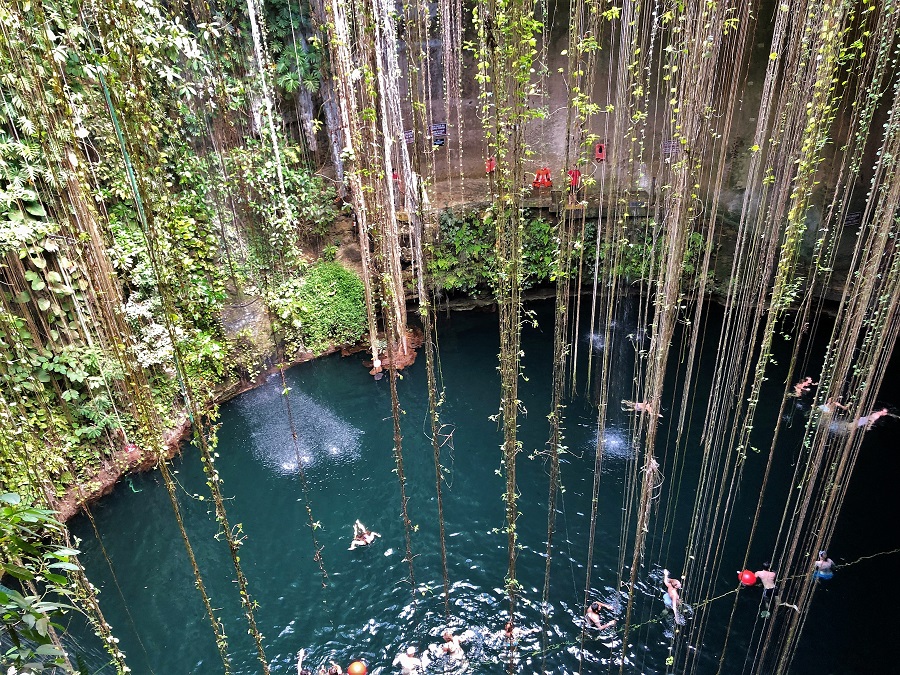
"Wow" we both said in unison. It was a stunning view down into this massive hole. To start with we were taken aback by the sheer size of the cenote, but it was also beautiful, with lush greenery clinging to the rock and long vines hanging from the surface, decorating the cenote like garlands, down to the clear blue water below.
"We have to come back here one day." wished Julie.
We spent a few minutes watching people jump from a high platform into the water. It looked like great fun. (I really must learn to swim), One young girl hesitated. She stood on the edge, attempting to muster up the courage to jump. It felt like the entire cenote was watching her, encouraging her to jump but all the attention made it worse. The pressure got too much. She bottled it and walked away.
With the entertainment over we moved on, returning to the restaurant we passed earlier.
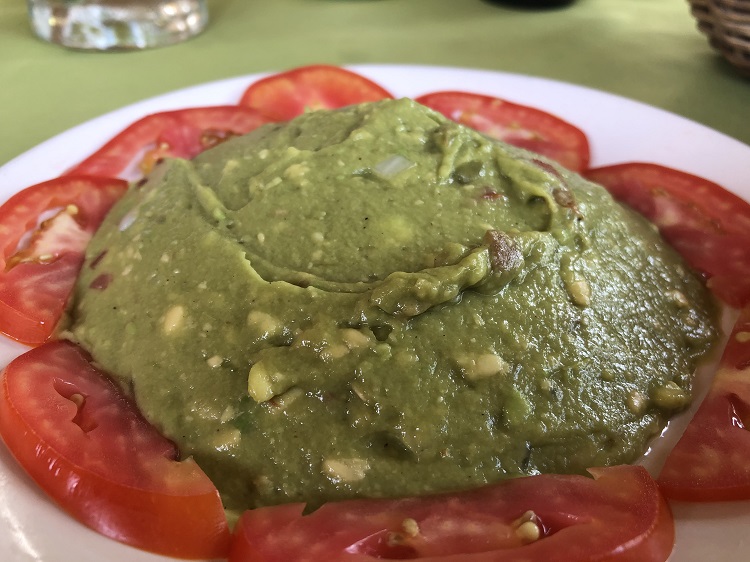
It may have been late but I wasn't especially hungry. I just ordered some quesadillas and guacamole.
They were large portions and at first I thought I would struggle but once I tasted them I couldn't stop! I wolfed it all down like I hadn't eaten in a week, scooping up the avocado dip with my warm cheese filled tortillas. They were devoured in minutes. They were so good.
The guacamole was so simple, yet incredibly delicious. Smooth with only a few flecks of onion, it was seasoned to perfection with salt and lime. I could have eaten a bucket full of it! I didn't want it to end. In fact I resorted to licking the plate!
Julie had a Club Sandwich. It looked the part, with layers of Chicken, Bacon and melted cheese.
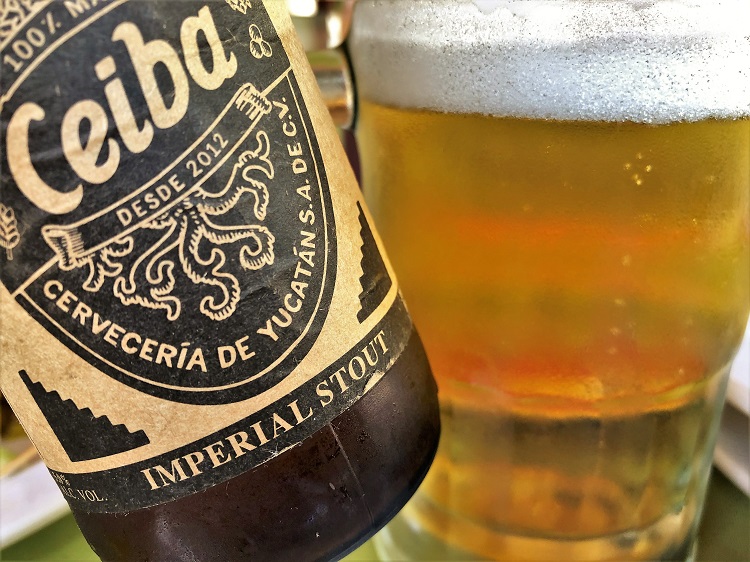
To drink they had a selection of craft beers from a local brewery in Mérida called Ceiba, named after the Mayan sacred tree of life. Their Imperial Stout was a real treat. I do enjoy a drop of the black stuff. It was so nice I ordered another bottle. This time however, despite the label, when I poured it out, an amber lager came out!
Trying to let the waiter know without sounding like I was complaining was a challenge.
Whilst eating lunch we watched this troop of Mayan gods trying to persuade visitors to stop for a photo with them. They weren't having much luck. They looked fabulous, resplendent in their feathered headress, with their faces and much of their bodies painted in bright colours.
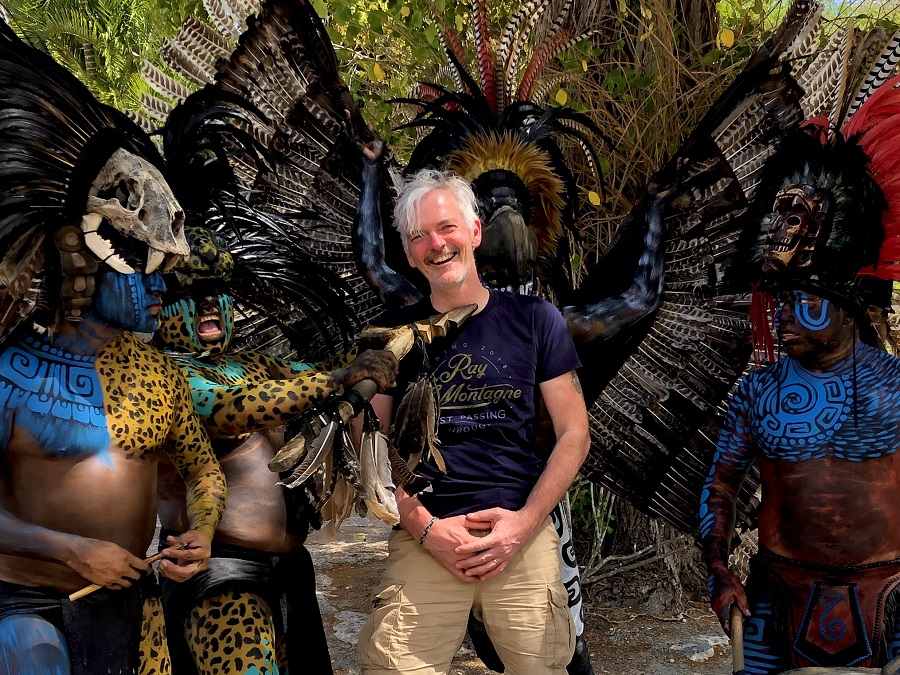
After lunch, we walked towards them on our way back to the car park. I had to stop for a photo. But I couldn't believe I had to wait!
Having watched them for the last twenty minutes unsuccesfully touting for business a couple who were walking just in front of us decided to stop.
Anyway, it was soon my turn. Julie took the photo as she didn't want to be in the photo. They all gathered around me, one held a (wooden) knife to my throat, and they all growled, barked or cheered. All they asked for was a small donation. I dropped a 100 pesos into their bucket.
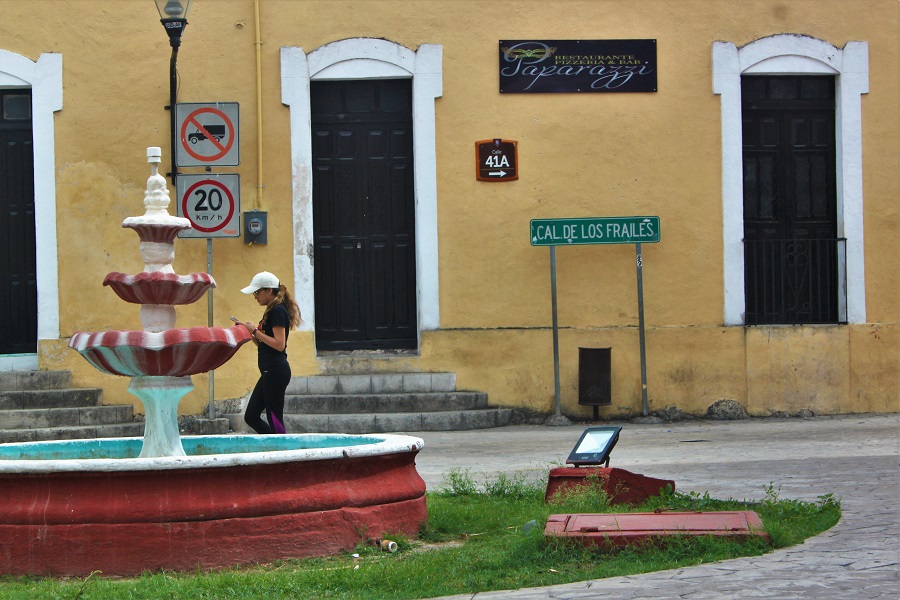
We met up with Diego who was all ready to take us to Valladolid but with a belly full of food we were feeling proper tired. He was still insistent on giving us our money's worth for the trip so he drove through the middle of the old town regardless.
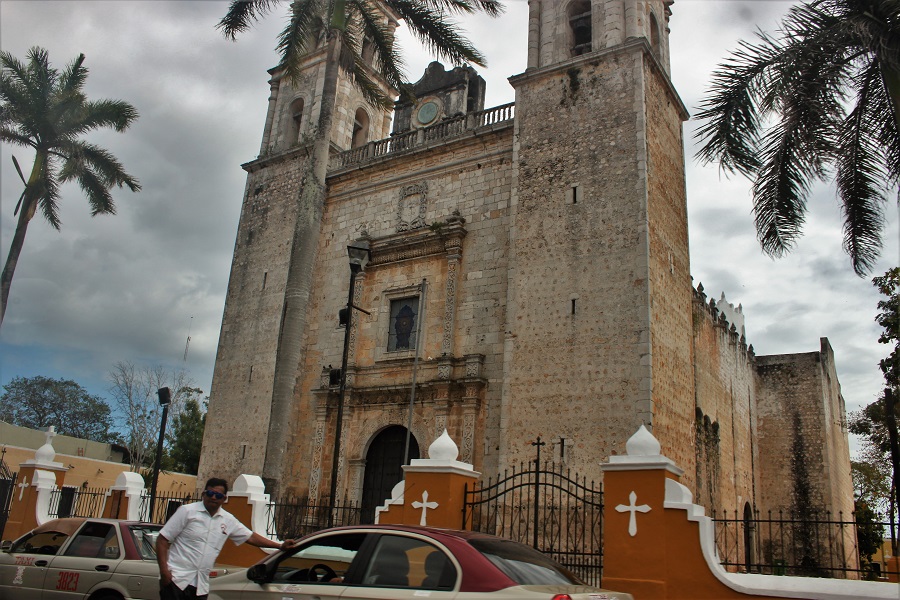
He slowed down as we drove through Parque Francisco Canton Rosado, a pretty square in the heart of the city with a 16th century church Iglesia de San Servacio down one end. He tried again, asking if we wanted to stop and have a look around but we hadn't changed our minds.
We continued through Valladolid and made our way back towards Tulum on Highway 180. After a few miles Diego asked if we would like to stop in Coba instead. He explained that it was a site of another Mayan ruin.
We gave into his persistence and agreed.
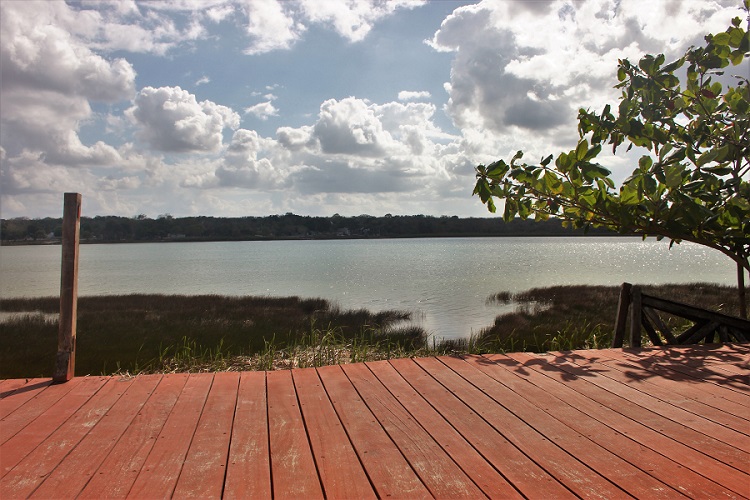
Coba is set near to two lakes, Lake Coba and Lake Macanxoc, a rare phenomenon in these parts as most of the water filters through the limestone into underground rivers.
We pulled up outside the entrance to the car park and arranged to meet up with Diego in an hour and half. The staff at the ticket booth reminded us that the site closed at 5pm, which wasn't strictly true as they had a sunset ticket for after 5pm until dark. Anyway, it was now 4pm so we had an hour before we had to leave.
Just inside there was a group of rickshaw peddlers hoping we would hire them to quickly scoot around the site. It was much more widespread than Chichen Itza, covering an estimated 30 square miles.
"It closes at 5pm" they reminded us. One guy suggested we should go straight to the great pyramid. "It's over a kilometer away" he added.
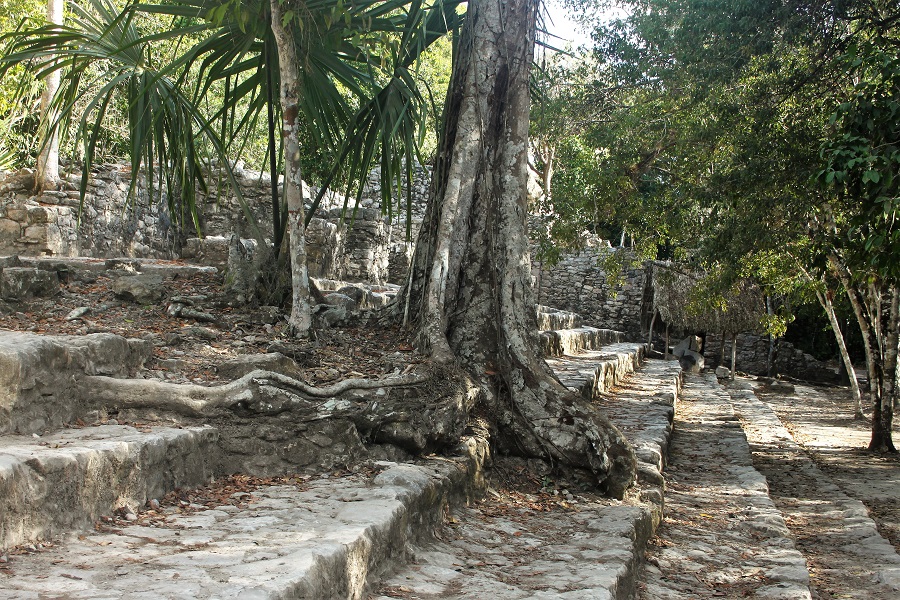
We took his advice, but not his rickshaw and followed the signs for the great pyamid of Coba. The jungle setting created a great atmotsphere. Ceiba trees grew on or around many of the smaller temples, their roots gripping around any rock that stood in its way. Reminding us much of Angkor.
Along the way we passed plenty of stone buildings, including a small ballcourt, but we didn't have time to stop. It took us twenty five minutes to reach a clearing in the woods where we came to an area known as Nohoch Muc which included the great pyramid temple of Ixmoja.
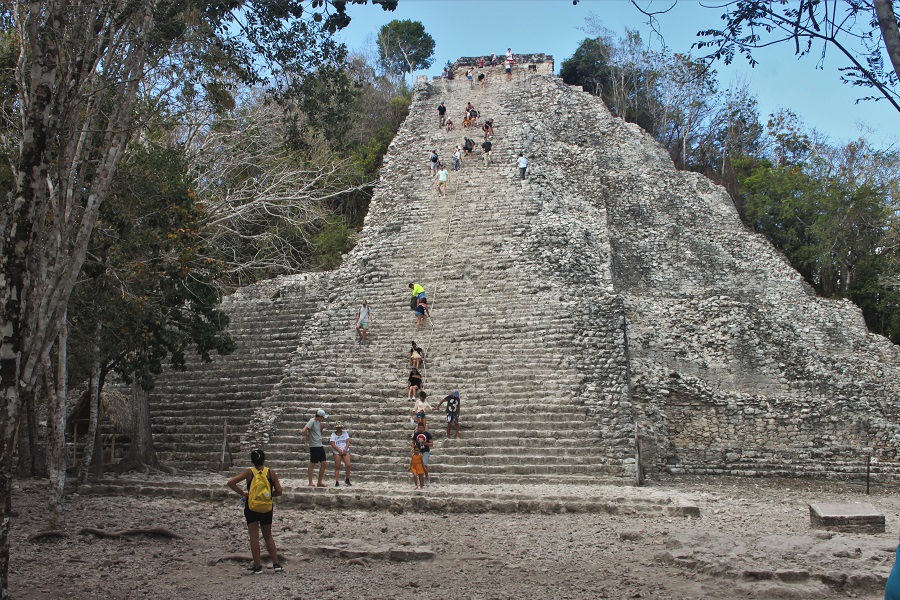
It looked like a pile of rubble, not perfectly restored like Chichen Itza's Temple of Kukulcan, a section of it had even collapsed to one side, but standing at 42 metres it was much taller than its more celebrated counterpart. In fact it was second only on the Mexican Yucatan peninsula to the great pyramid at Calakmul (near Xpujil).
Julie went to get some water from a kiosk whilst I went for a closer look. People were still climbing up the 130 steps to the top and I couldn't resist. I didn't look back in case Julie talked me out of it.
It began straightforward enough. The steps had been worn smooth and I was wearing my flip-flops which wasn't the most appropriate footwear but the steps were deep and gradual enough to manage. There was a rope in the centre but I didn't feel the need for it.
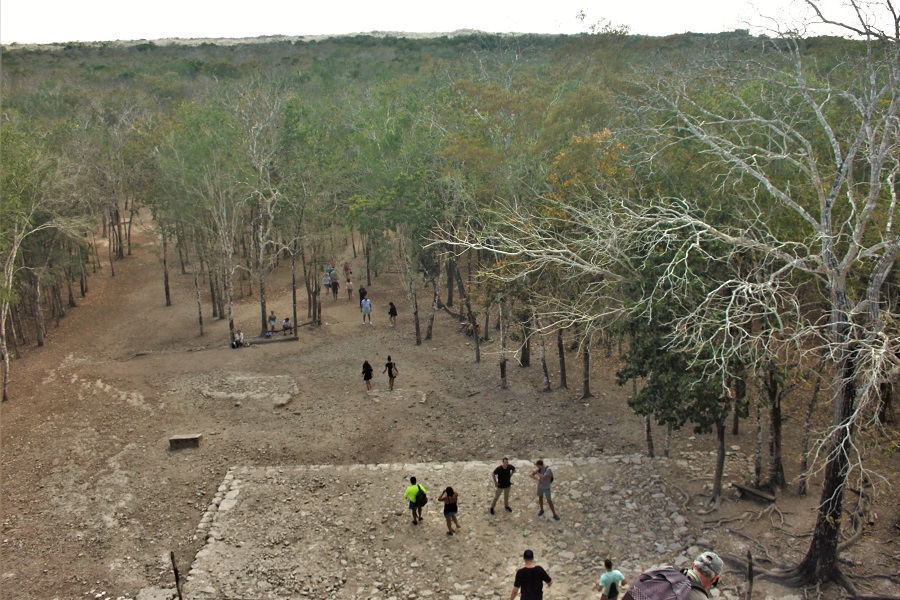
I don't think I was even half way when I stopped and looked beghind me to see I was already above the tree line. As I continued the ascent, the steps felt narrower and steeper until it got to the point I needed to clamber with my hands for extra stability. My heavy camera bag around my neck wasn't helping.
The closer to the top I got the nearer to the rope in the middle I got. The steps at the edges were in poor condition and forced me a little towards the centre, but also the security of that rope was drawing me towards it. In the end I reached out for it to steady my nerves as it got steeper and steeper.
Half a dozen steps from the end I came to the end of the rope. At the same time I was confronted with people coming down. They needed the rope more than I did so I had to let go. I stood upright and stepped to the side to let them pass. My legs were like jelly by now.
When the path was clear I completed the climb with my heart racing, adrenalin rushing, chest gasping, eyes wide open. I had never felt so alive!
As I got to the top, more people were just leaving, which left me (with the exception of a security guard discreetly tucked away in the shade of the crowning building), completely my own to savour the view.
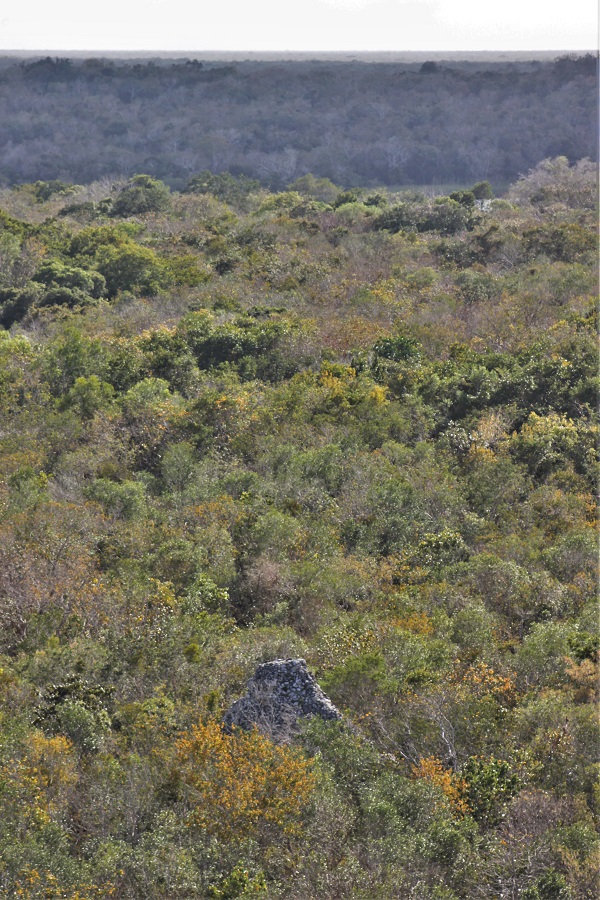
It was a carpet forest as far as the eye could see. Not far away the tip of another pyramid was just rising up above the trees. It must have been a small one as it wastn't topped with a platfrom or temple. Time slowed down. It was so peaceful. I felt I had been stood there for such a long time, but it would only have been a minute or two.
My solitude was disturbed when another couple arrived. I wasn't at all disappointed, I had my time. It was now theirs, so I left.
The descent was more nerve-racking than the climb. It was technically more difficult so I took my flip-flops off. I didn't want to risk a stumble because of my flimsy footwear. That would have been plain stupid. I think being barefooted was an advantage as I could feel the roughness or smoothness of the surface beneath my feet, making me cautious of every step but at the same time sure of them. It literally was one step at a time.
After a while I grew a little in confidence and was walking down more fluently but I was still grateful for the rope. I may have loosened my grip but I never let go .
Back down to earth I was greeted by a very relieved Julie who had felt every step I took.
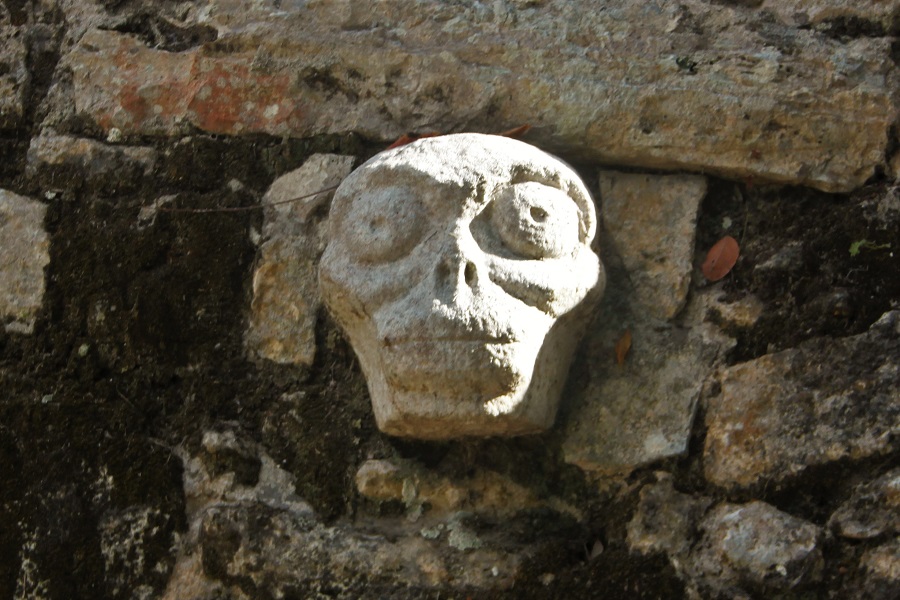
We didn't have long before we had to leave the complex so we began the long walk back through the forest. Quite near the exit we got distracted briefly by a small platform which must have been a tzompantli if the several skulls carved on the wall were anything to go by.
These weren't bas-reliefs but three dimensional carvings, these skulls were coming out of the rock.
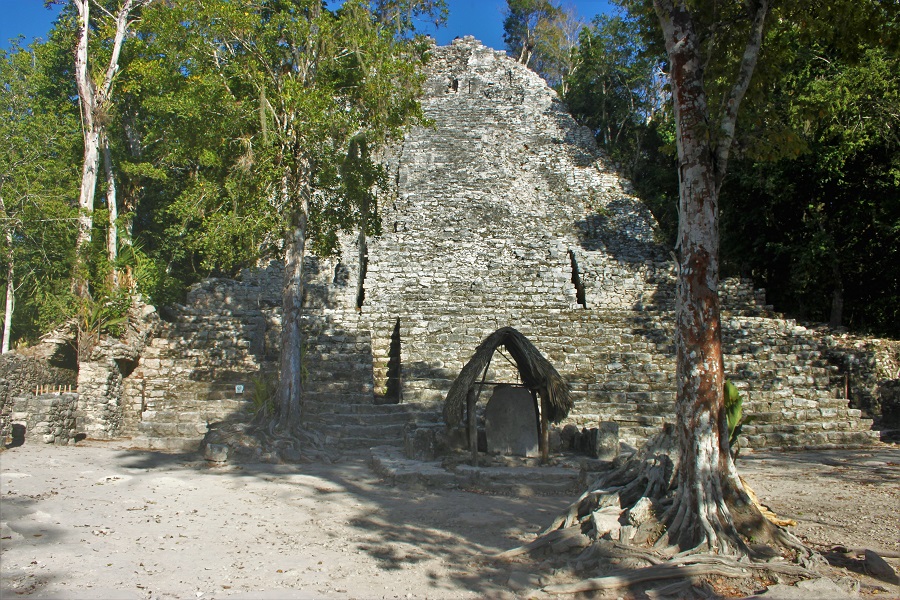
A little further a path lead away towards another pyramid, known as La iglesia or the church. We couldn't help but be drawn to it. We hadn't noticed it before, rushing past on the way to the Nohoch Muc group, but it was an impressive structure.
We didn't see any "Prohibido El Paso" signs but equally there wasn't a safety rope encouraging you to climb either. Shame. Apparently there was a glorious view of Lake Macanxoc from the top.
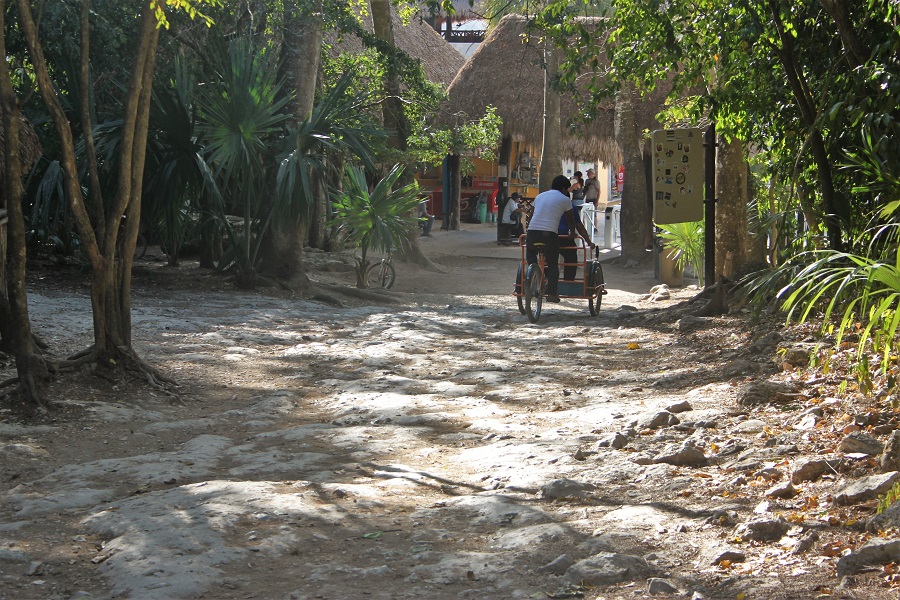
Time was running out so we didn't hang about. We literally walked throught the exit at precisely 5pm. We couldn't have timed it any better.
I have to say I was so grateful that we got to visit Coba. To walk through the jungle along sacred paths to climb to the top of a Mayan temple was an unforgettable experience. One that came close to easing the disappointment of missing out on Tikal.
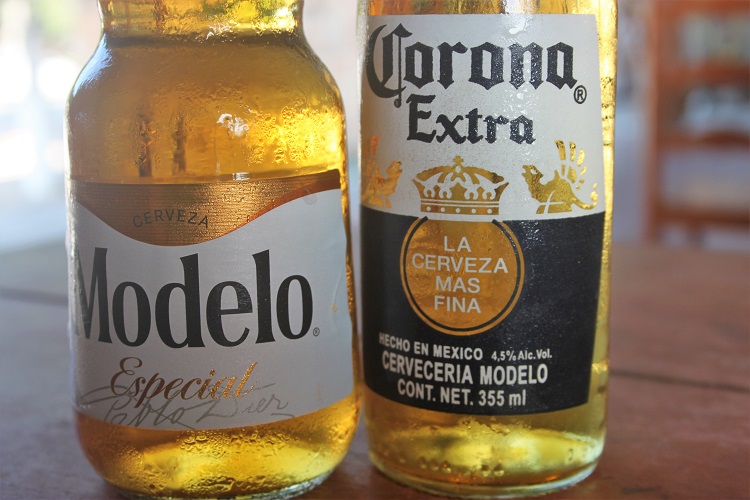
Diego wasn't expecting us back for another half an hour so we decided to pop into the on-site restaurant Ki-Hanal for a drink. I'm begining to get a taste for Mexican beer. Back home they wouldn't be my beer of choice, unless we're eating Mexican food. I find them too light in taste.
After refreshing oursleves we met up with Diego for the 30 mile drive home to Tulum. We were so weary we slept most of the way back.
Safely back at out hotel we resisted again the urge to simply crash out and go to bed. It was ony 6:30pm. We spent an hour unpacking our bags, folding them neatly onto the shelves or hanging them in the wardrobe
Before heading upstairs to the hotel restaurant for our supper, we did our now regular evening read of the news. We had two days of stories to catch up!
The one that grabbed our attention the most was the UK Foreign Secretary advised against all non-essential travel abroad.
"Does that mean we should we go home now?" asked Julie. I was reluctant to agree but we still checked available flights. The next seats on a direct flight from Cancun to London was on Friday but they were only business class. They would have set us back over £5000!! They had regular economy tickets next Monday but that was only a day before we were due to leave anyway. We decided to hold our nerve and hope for the best.
In other news, Glastonbury Festival has been cancelled and the Euro 2020 football tournament has been postponed until 2021. Also the Eurovision song contest has been cancelled. At least there is some silver lining!
UK death toll has now reached 104, and worldwide it has exceeded 8000. Fortunately Mexico still has none but that won't last, the number of cases have been rising steadily. The European Union decided to close its borders to most visitors for the next 30 days whilst Iran released 85,000 prisoners to stop it spreading within their prison system.
And finally, news that strikes fear into every parent was the announcement that schools in the UK will be closed from Friday.
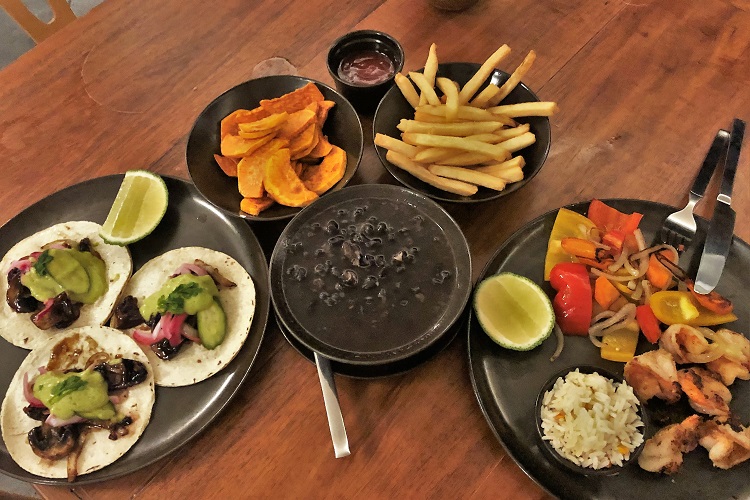
The evening had turned cool and breezy which was a nice three floors up on the rooftop terrace. They had a decent menu with plenty of choice.
I had some mushroom tacos which were delicious, really full of flavour. However, the side dish of beans was, like breakfast, as if they had just warmed up a tin of black beans. Also, all the time I was eating my more adventurous sweet potato chips I was wishing I had gone for the french fries. Julie enjoyed her grilled prawns withou enthusing too much about them.
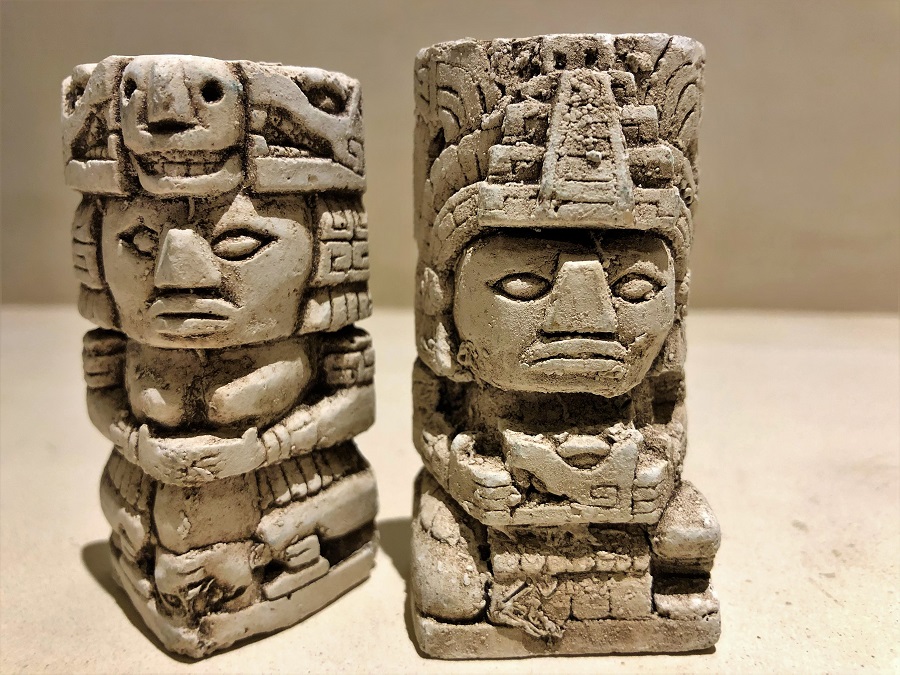
Back in the room I got our two little statues we bought today and placed them by my side of the bed. They were male and female deities now tasked with looking after us for the rest of our stay in Mexico.
It was only 9pm but it was lights out. We lay on the mattress for the first time since arriving and sunk into its welcoming comfort. It felt so good. It had been an epic 60 hours since leaving Rio Dulce on Monday morning. We were now looking forward to staying put in Tulum for the next week. Let the rest and relaxation part of the holiday begin!
Next day >